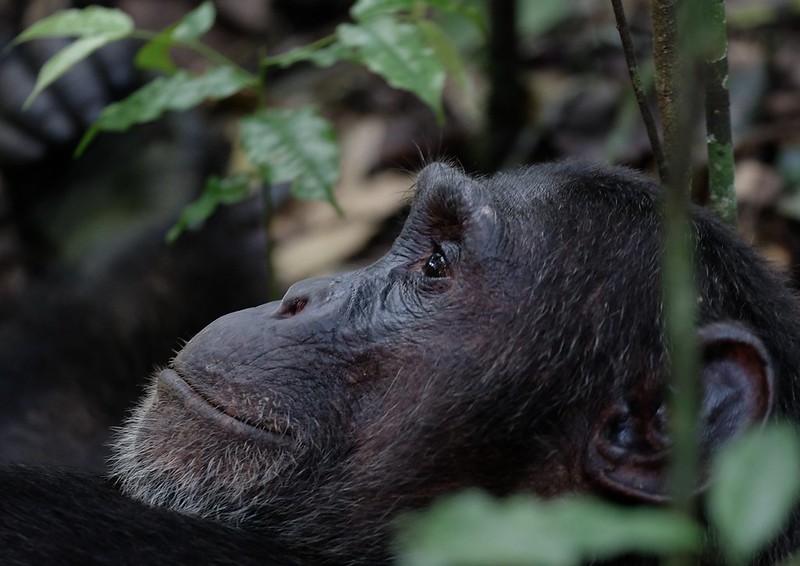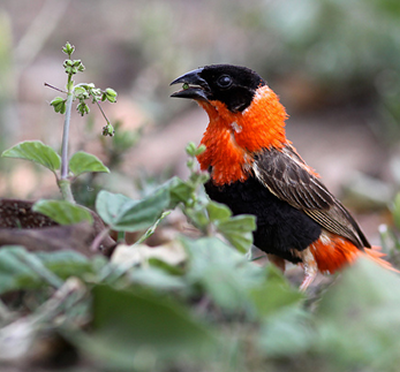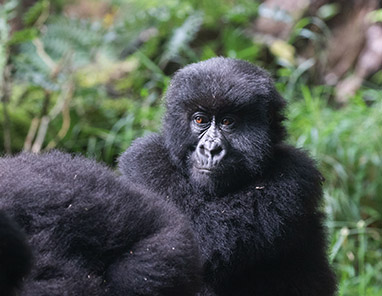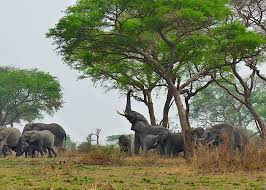Primates walk (Chimpanzee tracking)
The most favourite of Kibale’s walks embarks on from the Kanyanchu Visitor center at 08.00 & 15.00 and lasts 2 to 3 hours. Chimpanzee are the most sought after primate by visitors, but you should look out for the black & white colobus, red tailed monkey or the grey cheeked mangabey. Your guides will be able to show you pittas & different bird species and will give details of the tradit of the plant species within the forest. This walk is for 6 people in a group. Advance booking is all-important especially during peak sea.

Chimpanzee tracking has rules and regulations to follow
A distance of just about 8m is very important between you and the chimps.
People with diseases such as flue or diarrhea may not allowed in the park.
Avoid eating near the chimps.
Children below the age of 12 are prohibited from entering the park.
Guide is the only one to help get access to the forest.
Chimps need freedom therefore no provoking them once you enter the park.
Flash photography are not allowed in the park.
The most favorite activity in the park is the Chimpanzee tracking in Uganda. Starts from Kanyanchu Visitor Center at 08.00 & ends at 15.00 and lasts 2-3 hours. The Primates are searched down by visitors during the tracking. These include black & white Colobus, grey cheeked Mangabey, red tailed monkey. Your guides will show you pittas along with other bird species & will explain the tradition of different plant species within the forest. This walk is for 6 individuals per tour group. Advance booking is all-important during peak sea:
Chimpanzee tracking
Chimpanzee tracking actually is a very fascinating experience. Prepare today and set out to Uganda’s Kibale all natural jungle today as you spend a number of hours tracking these impressive creatures. You will be allowed to spend some time (at most an hour) with our mesmerizing relatives, as you observe them swing from one tree to another, feed, play about or progress speedily on the ground right in front of you.
Chimpanzees as well as humans share over 98 percent of their DNA.
However these being wild animals, chances of spotting these chimps are not always guaranteed although they are over 95% within the Kibale Forest, hence making it the most perfect destination in the whole of East Africa for chimpanzee tracking.
It is in addition probable to take part in the fascinating habituation experience, meaning that you can actuallty get a chance to spend the entire day with this impressive creatures.
However, because the number of chimpanzee trekking permits for each day is restricted, you are greatly advised to book in advance to your safari date.
Normally lunch boxes may be offered to the trekkers that are taking part in the habituation process since it requires the entire day.
Important to Note is that 15 years is the minimum age allowed to take part in the chimpanzee tracking experience
What to carry along
Wear shoes that have a good grip, suitable for climbing steep moist muddy slopes
A number of people actually feel more at ease when wearing clothes that are long sleeved as this will protect them from the pricking thickets as they move through the verdant jungle
Do not forget a rain gear, since the weather here is highly unpredictable
Bring enough drinking water plus snacks to bite on
Carry a pair of binoculars
If taking photos, keep in mind that your subjects are actually black animals living within dim light, so camera flashes is strictly not permitted. Better to have a fast film (of 400 – 800 ASA) or even utilize the settings on your camera.
About Chimpanzees
The average weight of an adult well grown male chimpanzee is between 35 and 70 kilograms, with a height of approximately 3 meters whereas tan adult female chimpanzee weighs between 26 and 50 kilograms and a height between 2 and 4 feet.
A chimpanzee’s life expectancy is at 40 years whereas that for those living in captivity can extend up to 60 years.
In Uganda today, Efforts to actually conserve the chimpanzees are extensively acknowledged and well supported. Actually The Jane Goodall Foundation has played a major role in the overall conservation of not only these Chimpanzees but the Gorillas as well found in Uganda. By going for chimpanzee tracking, you directly contribute to the conservation efforts.
Chimpanzees are the closest relatives to humans sharing about 98% of their DNA composition with humans. They are Sociable, intelligent as well as communicative and among their very fascinating traits is the ability to utilize tools like rocks for crushing nuts, empty pods for hollowing out water plus sticks for capturing termites from their holes. These skills are for long been passed on from generation to another and researchers say that different troops have specialist tasks, basing on their habitat as well as diet.
Chimps stay in groups of 10 – 100 members. They can babysit each other’s young, kiss, groom one another and even hold hands. The young chimps become independent at the age of 4 year. Nonetheless, chimps can be aggressive and unsociable, mainly if disturbed.
Although they spend some time on ground, they normally feed and do make their sleeping nests up in the trees. Their diet varies comprising of leaves, seeds, fruit plus flowers.
About Chimpanzee Habituation Experience
Chimpanzee Habituation Experience,this is a lifetime experience that allows accompany Kibale’s researchers and habituation at chimpanzee during their daily activities, thereby getting used to human presence without changing their natural. During your tour, expect coming across the chimps de-nesting (in their nocturnal nests) between 05.30 to 06.30, before them throughout the day till they make new nests and the night around 19.00. The Habituation Experience by tourist for low season months of March, April, May and November
For more details about your chimps trekking safari, contact Trots and Safaris at;
Web: www.trotsandsafari.com
Email: info@trotsandsafari.com
Lets join this fascinating experience with our close relatives in the wild.
PARK AT A GLANCE
Size: 220km² with an altitude of 670-760m above sea level
Semliki Forest Reserve was created in 1932 and upgraded to national park status in 1993.
It is the only tract of true lowland tropical forest in East Africa, hosting 441 recorded bird species and 53 mammals.
Large areas of this low-lying park may flood during the wet season,a brief reminder of the time when the entire valley lay at the bottom of a lake for seven million years.
Four distinct ethnic groups live near the park – Bwamba farmers live along the base of the Rwenzori while the Bakonjo cultivate the mountain slopes. Batuku cattle keepers inhabit on the open plains and Batwa pygmies, traditionally hunter gathers, live on the edge of the forest.
Semliki National Park sprawls across the floor of the Semliki Valley on the remote, western side of the Rwenzori. The park is dominated by the easternmost extension of the great Ituri Forest of the Congo Basin. This is one of Africa’s most ancient and bio-diverse forests; one of the few to survive the last ice age, 12-18,000 years ago.
The Semliki Valley contains numerous features associated with central rather than eastern Africa. Thatched huts are shaded by West African oil palms; the Semliki River (which forms the international boundary) is a miniature version of the Congo River, the forest is home to numerous Central African wildlife species, and the local population includes a Batwa pygmy community that originated from the Ituri. As a result, this park provides a taste of Central Africa without having to leave Uganda.
While Semliki’s species have been accumulating for over 25,000 years, the park contains evidence of even older processes. Hot springs bubble up from the depths to demonstrate the powerful subterranean forces that have been shaping the rift valley during the last 14 million years.
size: 795km2
Kibale is highest at the park’s northern tip, which stands 1,590m above sea level. The lowest point is 1,100m on the floor of the Albertine Rift Valley to the south.
over 351 tree species have been recorded in the park, some rise to over 55m and are over 200 years old.
Kibale’s varied altitude supports different types of habitat, ranging from wet tropical forest on the Fort Portal plateau to woodland and savanna on the rift valley floor.
Kibale is one of Africa’s foremost research sites. While many researchers focus on the chimpanzees and other primates found in the park, others are investigating Kibale’s ecosystems, wild pigs and fish species, among other topics.
Kibale National Park contains one of the loveliest and most varied tracts of tropical forest in Uganda. Forest cover, interspersed with patches of grassland and swamp, dominates the northern and central parts of the park on an elevated plateau.Kibale is famously known for Chimpanzee tracking
The park is home to a total of 70 mammal species, most famously 13 species of primate including the chimpanzee.
It also contains over 375 species of birds. Kibale adjoins Queen Elizabeth National Park to the south to create a 180km-long corridor for wildlife between Ishasha, the remote southern sector of Queen Elizabeth National Park, and Sebitoli in the north of Kibale National Park.The Kibale-Fort Portal area is one of Uganda’s most rewarding destinations to explore. The park lies close to the tranquil Ndali-Kasenda crater area and within half a day’s drive of the Queen Elizabeth, Rwenzori Mountains and Semuliki National Parks, as well as the Toro-Semliki Wildlife Reserve
PARK AT A GLANCE
Size: 33.7km2, making it Uganda’s smallest National Park.
The park takes its name from “Gahinga” – the local word for the piles of volcanic stones cleared from farmland at the foot of the volcanoes.
The British administration declared the area a game sanctuary in 1930; it was gazetted as a National Park in 1991.
Mgahinga has one habituated trans-boundary gorilla group.
The Batwa were self-sufficient – and visitors can see how during a fascinating tour with a Batwa guide to learn the secrets of the forest.
Mgahinga Gorilla National Park sits high in the clouds, at an altitude of between 2,227m and 4,127m. As its name suggests, it was created to protect the rare mountain gorillas that inhabit its dense forests, and it is also an important habitat for the endangered golden monkey.
As well as being important for wildlife, the park also has a huge cultural significance, in particular for the indigenous Batwa pygmies. This tribe of hunter-gatherers was the forest’s “first people”, and their ancient knowledge of its secrets remains unrivalled.
Mgahinga’s most striking features are its three conical, extinct volcanoes, part of the spectacular Virunga Range that lies along the border region of Uganda, Congo and Rwanda. Mgahinga forms part of the much larger Virunga Conservation Area which includes adjacent parks in these countries. The volcanoes’ slopes contain various ecosystems and are biologically diverse, and their peaks provide a striking backdrop to this gorgeous scenery.
PARK AT A GLANCE
Size: 1,978km².
Queen Elizabeth spans the equator line; monuments on either side of the road mark the exact spot where it crosses latitude 00. The park was founded in 1952 as Kazinga National Park, and renamed two years later to commemorate a visit by Queen Elizabeth II. The park is home to over 95 mammal species and over 600 bird species.
The Katwe explosion craters mark the park’s highest point at 1,350m above sea level, while the lowest point is at 910m, at Lake Edward.
Queen Elizabeth National Park is understandably Uganda’s most popular tourist destination. The park’s diverse ecosystems, which include sprawling savanna, shady, humid forests, sparkling lakes and fertile wetlands, make it the ideal habitat for classic big game, ten primate species including chimpanzees and over 600 species of birds.
Set against the backdrop of the jagged Rwenzori Mountains, the park’s magnificent vistas include dozens of enormous craters carved dramatically into rolling green hills, panoramic views of the Kazinga Channel with its banks lined with hippos, buffalo and elephants, and the endless Ishasha plains, whose fig trees hide lions ready to pounce on herds of unsuspecting Uganda kob.
As well as its outstanding wildlife attractions, Queen Elizabeth National Park has a fascinating cultural history. There are many opportunities for visitors to meet the local communities and enjoy storytelling, dance, music and more. The gazetting of the park has ensured the conservation of its ecosystems, which in turn benefits the surrounding communities.
Discover queen elizabeth wonders with trotsandsafaris.
Web: www.trotsandsafari.com
Email: info@trotsandsafari.com




